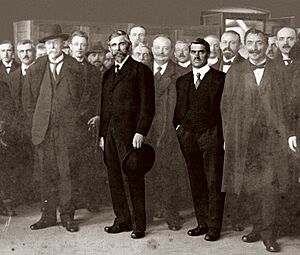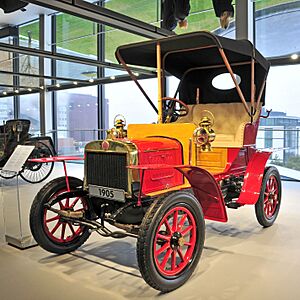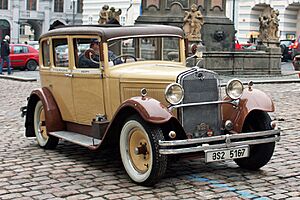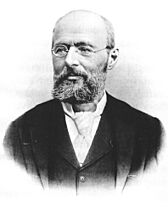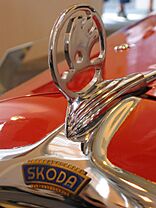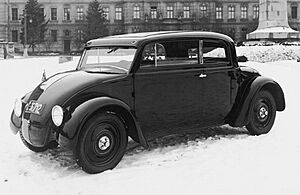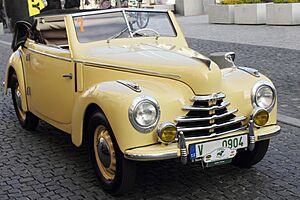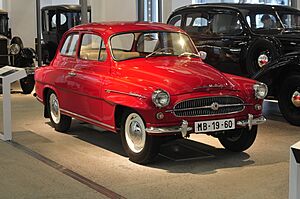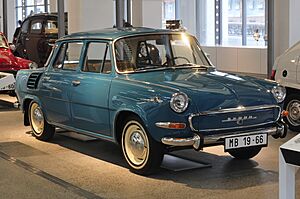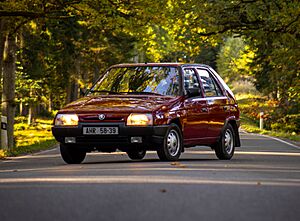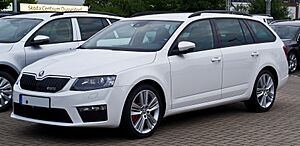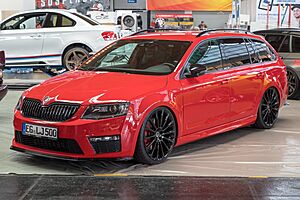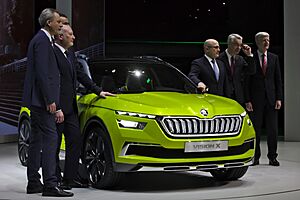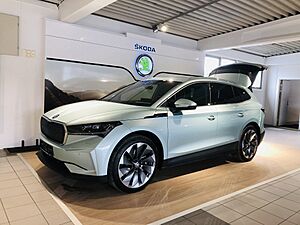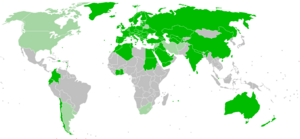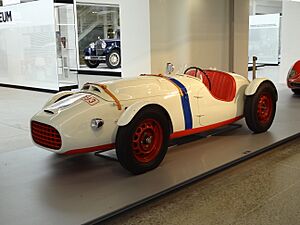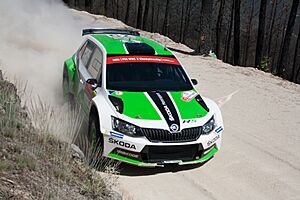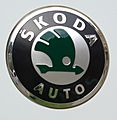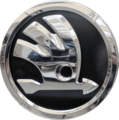Škoda Auto facts for kids
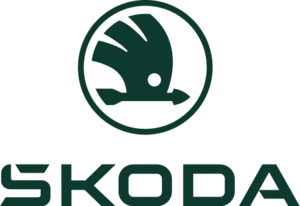
Logo since 2023
|
|
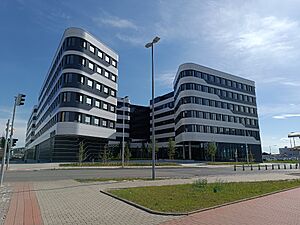
Headquarters in Mladá Boleslav, Czech Republic, 2024
|
|
| Subsidiary | |
| Industry | Automotive |
| Predecessor | Laurin & Klement |
| Founded | 1925 |
| Founder | Václav Laurin and Václav Klement |
| Headquarters | , |
|
Area served
|
Worldwide (except Japan, and North America) |
|
Key people
|
Klaus Zellmer (CEO) |
| Products | Automobiles |
|
Production output
|
|
| Revenue | |
|
Operating income
|
|
| Total assets | |
| Total equity | |
|
Number of employees
|
|
| Parent | Volkswagen Group |
| Subsidiaries | Škoda Auto Česká republika Škoda Auto Deutschland GmbH Škoda Auto Slovensko s.r.o. Škoda Auto Volkswagen India |
Škoda Auto a.s. (often called Škoda) is a famous Czech car maker. It started in 1925, taking over from a company called Laurin & Klement. Its main office is in Mladá Boleslav, Czech Republic.
After 1948, Škoda became owned by the state. Then, after the Velvet Revolution in 1991, it slowly became a private company again. By 2000, it was fully owned by the German car giant, Volkswagen Group.
Škoda cars are sold in over 100 countries around the world. In 2018, the company sold 1.25 million cars. This was a 4.4% increase from the year before. Škoda's profit margin was the second highest among all Volkswagen brands in 2017, right after Porsche.
Contents
The Story of Škoda Cars
The original Škoda Works company was started by a Czech engineer named Emil von Škoda in 1859. This was in a city called Plzeň, which was then part of the Austrian Empire. The company first made weapons. It grew into one of Europe's biggest industrial groups in the 20th century. Today's Škoda Auto, along with other companies like Doosan Škoda Power and Škoda Transportation, came from this original company. Even though Škoda is named after its founder, the word "škoda" also means "pity" or "shame" in the Czech language.
How Laurin & Klement Started
Like many old car companies, Škoda Auto began by making bicycles. The company, then called Laurin & Klement, started in 1896. They made a type of bicycle called a velocipede.
In 1894, a 26-year-old bookseller named Václav Klement lived in Mladá Boleslav. He couldn't get parts to fix his German bicycle. When he wrote to the makers in Czech, they replied in German, telling him to write in a language they understood. Klement wasn't happy. He saw a business chance and decided to open a bicycle repair shop. He teamed up with Václav Laurin in 1896. Laurin was already a bicycle maker in a nearby town.
In 1898, after moving to a new factory, they bought a "Werner Motocyclette." Their first motorcycle was dangerous. It had an engine on the handlebars that drove the front wheels. Laurin even lost a front tooth in an accident! To make a safer machine, they asked German expert Robert Bosch for advice. Their new Slavia motorcycle came out in 1899. Their company became the first motorcycle factory in Central Europe. By 1900, they had 32 workers and started exporting motorcycles to London.
By 1905, the company was making cars. This made them the second-oldest car maker in the Czech lands, after Tatra. Their first car, the Voiturette A, was very successful. The company became well-known both in Austria-Hungary and around the world.
Škoda Takes Over
After World War I, Laurin & Klement started making trucks. But in 1924, they faced problems, including a factory fire. They needed a new partner.
Meanwhile, the Škoda Works, a large arms maker in Plzeň, wanted to make more non-military products. So, in 1925, they bought Laurin & Klement. Škoda Works also started making cars with Hispano-Suiza. Most cars made after this were sold under the Škoda name.
From 1930, cars were made using an assembly line. Also in 1930, the car part of the company became a new company called ASAP. ASAP was still fully owned by Škoda Works. It sold cars under the Škoda brand. The car factory in Mladá Boleslav was very large and had 3,750 factory workers and 500 office workers.
In 1932, ASAP-Škoda made a prototype car called the Škoda 932. It was a streamlined, two-door car with a rear engine. Its design looked a lot like small cars that would come out later.
After a tough economic time, Škoda launched new cars in the 1930s. These cars were very different from their older models. They had a new type of chassis with a strong central tube and independent suspension for all wheels. This design helped solve problems with the car's frame.
This new chassis was used for popular models like the Popular, Rapid, Favorit, and Superb. In 1933, Škoda had 14% of the car market in Czechoslovakia. But by 1936, with the new designs, Škoda became the market leader. By 1938, they had 39% of the market.
During World War II
During World War II, when Czechoslovakia was occupied, the Škoda Works helped the German war effort. They made parts for military vehicles, planes, and other weapons. Car production dropped a lot, from 7,052 cars in 1939 to only 683 in 1944. Only 35 of these were passenger cars. Between January and May 1945, 316 trucks were made. The Škoda factories were bombed many times by UK and US air forces. A huge air raid on April 25, 1945, almost completely destroyed the Škoda weapons factory.
After World War II
By July 1945, the Mladá Boleslav factory was rebuilt. Production of Škoda's first car after the war, the 1101 series, began. It was an updated version of the pre-war Škoda Popular. In 1948, Škoda became part of the communist government's plan for the economy. This meant it was separated from the original Škoda Works company. Even with difficult political times, Škoda kept a good reputation until the 1960s. They made models like the Škoda 440 Spartak, 445 Octavia, Felicia, and Škoda 1000 MB.
From 1957, Škoda cars like the Octavia and Felicia were sold in the United States. Some American buyers wanted smaller cars. But Škoda dealerships in the U.S. faced problems because of the Cold War. The cars also weren't well supported after sale, making repairs hard. U.S. sales were highest in 1959 but fell quickly after 1960. Škoda hasn't sold cars in the U.S. since then, but they did sell cars in Canada from 1984 to 1990.
In the late 1980s, Škoda was still making cars with designs from the 1960s. These cars, like the Škoda 105/120 (Estelle) and Rapid, had their engines in the back. They were sold as budget cars in Western Europe. Even so, they sold well and did great in races like the RAC Rally in the 1970s and 1980s. They won their class in this rally for 17 years in a row! Despite jokes about their old-fashioned image, Škodas were common on roads in the UK and Western Europe.
Sporty versions of the Estelle and older models were made, called "Rapid." There were also soft-top versions. The Rapid was sometimes called the "poor man's Porsche" and sold very well in the UK in the 1980s.
In 1987, the Favorit was launched. It was a modern front-wheel drive hatchback. Its look was designed by the Italian company Bertone. Škoda engineers designed a car that could compete with Western cars, even though it still used a Škoda-designed engine. The Favorit was very popular in Czechoslovakia and other Eastern European countries. It also sold well in Western Europe, especially in the UK and Denmark, because it was affordable and reliable. The Favorit continued to be sold until the Felicia was introduced in 1994.
Becoming Part of Volkswagen Group
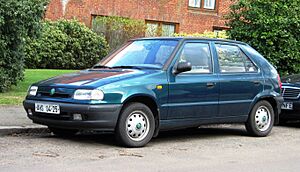
Before 1990, Škoda was still making older rear-engined cars. But they had started making the Favorit front-wheel drive car in 1987 to replace them.
After the fall of communism and the Velvet Revolution, many industries in Czechoslovakia became private. For Škoda Automobile, the government looked for a strong foreign partner. Many companies were interested, including BMW, GM, Renault, Volvo, Volkswagen, Ford, Fiat, and Mercedes-Benz.
Volkswagen offered to keep making the Favorit and to keep the Škoda brand, including its research and development. Volkswagen offered to buy 30% of Škoda shares, and slowly increase it to 70%. The Czech government chose Volkswagen on December 9, 1990. On March 28, 1991, a partnership agreement with Volkswagen was made. Volkswagen first bought 30% of Škoda, then increased its share to 70% by 1995. By May 30, 2000, Volkswagen AG bought the remaining 30%, making Škoda Auto a fully owned part of the Volkswagen Group.
With Volkswagen's help and money, Škoda's car designs and engineering improved a lot. The 1994 Felicia model was an updated Favorit, but its quality and features were much better. In the Czech Republic, it was seen as good value and became popular. Sales improved across Europe. In the UK, Škoda cars started ranking high in customer satisfaction surveys.
Ferdinand Piëch, the chairman of Volkswagen AG, chose Dirk van Braeckel to lead Škoda's design. The new Octavia and Fabia models were then sold in demanding European markets. These cars were built on common Volkswagen Group car platforms. The Fabia, launched in late 1999, was used as the base for later versions of the Volkswagen Polo and SEAT Ibiza. The Octavia, launched in 1996, shared its platform with many cars, including the popular Volkswagen Golf Mk4.
Škoda's image in Western Europe changed completely after Volkswagen took over. In the 1980s, Škoda cars were sometimes joked about. But as the cars got better and new models came out, Škoda's image slowly improved. In the UK, a clever advertising campaign in 2000, called "It is a Škoda, honest," helped a lot. In one TV ad, a new worker on the production line doesn't put Škoda badges on good-looking cars because he thinks they "cannot be Škodas." This campaign directly faced Škoda's image problem, which was a risky move but it worked. By 2005, Škoda was selling over 30,000 cars a year in the UK.
In 1991, Škoda made 172,000 cars and exported 26% of them to 30 countries. By 2000, it made 435,000 cars and exported 82% to 72 countries.
Growth and New Models
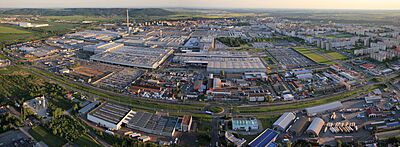
2010 was a very important year for Škoda Auto. Winfried Vahland became the CEO. Škoda also announced plans to double its yearly sales to at least 1.5 million cars by 2018. This plan was called the 'Growth Strategy'.
At the 2010 Paris Motor Show in September 2010, Škoda showed off the Octavia Green E Line. This was an electric car concept. The last first-generation Octavia was made in November 2010. Over 1.4 million of this model had been made since 1996. In 2010, for the first time, China bought more Škoda cars than Germany, becoming Škoda's biggest market.
In 2011, Škoda Auto celebrated 20 years of working with the Volkswagen Group. Over 75,000 people visited an open house event in Mladá Boleslav. Earlier that year, the company shared details of its 2018 Growth Strategy: to release at least one new or updated car model every six months. With this goal, Škoda changed its logo and brand look at the 2011 Geneva Motor Show. Škoda also showed the VisionD design concept, which hinted at the future third-generation Octavia. They later showed the MissionL design study, which became the basis for the European Rapid.
In 2011, Škoda started making the new Rapid model in Pune, India. They also launched the Škoda Citigo in Slovakia. In 2012, Škoda introduced two new mass-produced models. The European version of the Rapid was shown at the 2012 Paris Motor Show. This car was meant to be a successor to the first-generation Octavia in terms of price. The second model was the third-generation Octavia, which came out in December 2012.
In 2012, Škoda also started using a fleet of Octavia Green E Line electric cars on Czech roads for testing. Škoda celebrated several big achievements that year, including making 14 million Škoda cars since 1905, three million Fabias, and 500,000 Superbs.
2013 was a big year for new Škoda models. The company launched the third-generation Octavia Combi and Octavia RS. They also updated the Superb and Superb Combi. New members of the Rapid family were introduced, like the Rapid Spaceback, Škoda's first hatchback in the compact car size. The Yeti also got big updates, with two versions: a city-style Yeti and a rugged Yeti Outdoor.
In 2015, Volkswagen admitted that it had used special software in many of its cars to trick tests about pollution. About 1.2 million Škoda cars had this software. Škoda said that Volkswagen would fix all the affected cars for free. In 2015, Škoda was voted the most reliable car brand in the UK. A new company plan was launched in 2015 to make a range of all-electric cars starting in 2019.
Škoda Auto began making the large, seven-seat SUV Škoda Kodiaq in 2016. Sales started in early 2017. In late 2017, sales began for the new compact SUV Škoda Karoq, which replaced the Škoda Yeti. In December 2018, the carmaker introduced a new small family car, the Škoda Scala. In February 2019, the company showed the new subcompact crossover Škoda Kamiq in Geneva.
Electric Car Plans
In 2015, Škoda's chairman, Bernhard Maier, said that the Volkswagen Group was working on a new electric car platform and that Škoda was part of the team. He said there was "no alternative to electrification." Škoda's new "Strategy 2025" aims to start making a fully electric car in 2020. They plan to have five electric models in different sizes by 2025.
At Auto Shanghai in 2017, Škoda showed its Vision E concept. This was an all-electric SUV with a coupé-like shape. It could drive itself at a certain level and had a range of 500 kilometers. It uses the VW MEB platform. Škoda Auto also makes electric-vehicle batteries for the Volkswagen Group in the Czech Republic. A second version, the Škoda Vision iV, was shown in March 2019.
A plug-in hybrid car, the Škoda Superb iV, became available in early 2020. A small SUV model, Škoda Kamiq, with a natural gas-electric hybrid engine, and a hybrid Fabia were also planned for later that year. By March 2018, the plan for electric cars grew to 10 electric models by 2025. This includes six fully electric cars and four plug-in hybrids. Five of these models were planned to be available by 2020. In 2018, the brand started its biggest investment plan ever, putting €2 billion over five years into electric cars.
The brand's first fully electric car, a small city car called Škoda Citigo-e iV, was sold from 2019 to 2020. The all-electric Škoda Enyaq iV has been available since September 2020. The Škoda Enyaq Coupé has been sold since May 2023.
Sales and Markets Around the World
Škoda has been financially strong in recent years. In 2013, the company made €10.3 billion in sales. Even with a weak economy in many European countries, their operating profit was €522 million. Škoda had a great start to 2014. They delivered the most cars ever in a first quarter (247,200 cars, up 12.1%). Sales revenue increased by 23.7% to almost €3 billion. Operating profit went up by 65.2% to €185 million compared to the year before.
Where Škoda Cars are Sold
As of August 2016, Škoda cars were sold in 102 countries. In 2022, the top countries for Škoda sales were Germany (134,260 cars), Czech Republic (71,152 cars), India (51,865 cars), Great Britain (49,555 cars), and Poland (44,985 cars). In Asia-Pacific, Škoda is also sold in Australia, New Zealand, Taiwan, and Brunei. Škoda also planned to expand into Iran, with imports starting in 2018 and car production by 2020. They also planned to expand into Singapore.
Where Škoda Cars are Made
Škoda cars are made in factories in the Czech Republic (635,213 cars), India (55,750 cars), China (41,936 cars), and Slovakia (16,116 cars). A smaller number of Škoda models are also made in Solomonovo, Ukraine by a local partner. Until 2020, cars were made in Öskemen, Kazakhstan. Cars were also built in two places in Russia, but this stopped after the Russian invasion of Ukraine in 2022.
Motorsport Success
The Škoda brand has been involved in motor sports since 1901. They have won many titles around the world with different cars. The team competed as a manufacturer in the Intercontinental Rally Challenge (before it joined with ERC in 2013) and World Rally Championship from 1999 to 2005. Now, they compete in the European Rally Championship and WRC-2.
Until the last season of IRC in 2012, Škoda Motorsport was the most successful manufacturer. They won the rallying series from 2010 to 2012. Since 2013, when the two racing series merged, they have continued to compete in the European Rally Championship.
Škoda Motorsport drivers won the European Rally Championships from 2012 to 2014 with the Škoda Fabia S2000.
World Rally Championship Races
After many wins in lower levels of motorsport, Škoda joined the FIA World Rally Championship in 1999. They used World Rally Car models of the Škoda Octavia. Škoda's best result with the Octavia WRC was Armin Schwarz's third place at the 2001 Safari Rally. From mid-2003, the Octavia was replaced by the smaller Škoda Fabia. Škoda then left the series. In 2006, Škoda was represented by the privateer Red Bull Škoda Team. Jan Kopecký drove the Fabia WRC to fifth place at the Rally Catalunya.
WRC2 Races
In 2009, Škoda entered the Intercontinental Rally Challenge (IRC) for the first time, using the Fabia S2000. They won three rallies and finished second in both the drivers' and manufacturers' championships. In 2010, Škoda won seven IRC events, winning both the manufacturers' and drivers' championships for Juho Hänninen. They repeated these wins in the next two seasons. In 2013, the Intercontinental Rally Challenge merged with the European Rally Championship (ERC), and the team won the drivers' championship again for Jan Kopecký.
Škoda Motorsport won the 2015, 2016, 2017, and 2018 WRC-2 championships with the Škoda Fabia R5.
Bonneville Speedway Record
In August 2011, a special Škoda Octavia vRS set a world record at the Bonneville Speedway. It became the fastest production car in the world with an engine up to two liters, reaching 227 miles per hour. The fastest production Škoda car today is the Škoda Superb III. It has a top speed of 250 kilometers per hour and can go from 0 to 100 kilometers per hour in 5.8 seconds.
Current Škoda Models
- Škoda Enyaq – An all-electric crossover SUV (since 2020)
- Škoda Elroq – An all-electric crossover SUV (since 2025)
- Škoda Kodiaq II – A large SUV (since 2023)
- Škoda Karoq – A compact SUV (since 2017)
- Škoda Kamiq – A crossover SUV (since 2019)
- Škoda Kushaq – A crossover SUV (since 2021)
- Škoda Kylaq - A subcompact crossover SUV (since 2024)
- Škoda Superb IV – A compact executive car (since 2023)
- Škoda Octavia IV – A small family car (since 2019)
- Škoda Slavia – A subcompact car (since 2022)
- Škoda Scala – A small family car (since 2019)
- Škoda Fabia IV – A supermini car (since 2021)
-
Škoda Superb IV (since 2023)
-
Škoda Octavia IV (since 2019)
-
Škoda Fabia IV (since 2021)
The Škoda Logo
In 1923, two different logos were registered for Škoda. One showed a winged arrow pointing right with five feathers in a circle. The other was a winged arrow with three feathers. The famous winged arrow with three feathers is still the Škoda logo today. The word ŠKODA was added to the logo in 1936.
The arrow in the logo stands for speed. The wings represent progress and freedom. The eye means precision, and the circle means unity, completeness, and harmony. A story says that Emil von Škoda was inspired by a Native American's feathered headdress during his travels in the US.
See also
 In Spanish: Škoda para niños
In Spanish: Škoda para niños
- List of automobile manufacturers of the Czech Republic
- Škoda Works
- Avia
- Tatra
- Praga


